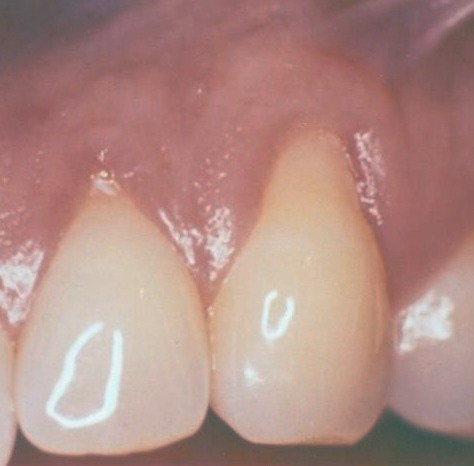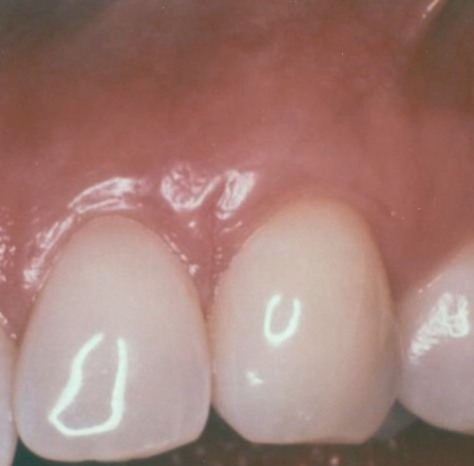Connective Tissue Grafting
In a healthy mouth that has experienced no tissue loss; a firm band of gum tissue surrounds the crown of the tooth. This firm band of "bound down" tissue (of the type that covers the entire roof of the mouth) is meant to protect the root surfaces of the teeth by resisting abrasion caused by chewing hard foods, lip movement, and tooth brushing.
 Sometimes, for various reasons, this band of firm tissue is minimal or missing.
This can result in very sensitive gums which become inflamed easily, gum recession, root surface sensitivity, and occasionally tooth loss.
Sometimes, for various reasons, this band of firm tissue is minimal or missing.
This can result in very sensitive gums which become inflamed easily, gum recession, root surface sensitivity, and occasionally tooth loss.
Recession may be influenced by any of the following:
- Over-zealous tooth brushing either with a hard brush or brushing too vigorously with a soft brush
- Location of the tooth in the jaw bone
- Quality and thickness of the tissue
- Amount of bone surrounding the tooth root
- Periodontal disease
- Effectiveness of oral hygiene techniques
- Abfraction (a process that may cause grooves to form on the root surfaces of the tooth when a person grinds or clenches their teeth).
 Connective tissue grafting can potentially restore this band of firm tissue. For the donor graft material, a small piece of tissue is removed from under the surface of the roof of the mouth (palate) close to the teeth. It is then placed at the prepared recipient site where it will help to restore the lost tissue. Although this procedure will normally result in a nice band of "bound down" tissue, the degree to which an exposed root surface can be covered depends on the height of the adjacent bone and gum tissue between the teeth. Exposed root surfaces cannot always be covered completely, particularly in the lower teeth. In the example shown, there was no adjacent gum or bone loss prior to grafting.
Connective tissue grafting can potentially restore this band of firm tissue. For the donor graft material, a small piece of tissue is removed from under the surface of the roof of the mouth (palate) close to the teeth. It is then placed at the prepared recipient site where it will help to restore the lost tissue. Although this procedure will normally result in a nice band of "bound down" tissue, the degree to which an exposed root surface can be covered depends on the height of the adjacent bone and gum tissue between the teeth. Exposed root surfaces cannot always be covered completely, particularly in the lower teeth. In the example shown, there was no adjacent gum or bone loss prior to grafting.
When the donor tissue is taken from the palate, an acrylic stent is normally made to cover the donor site for a few days after the surgery. The stent helps to prevent post-operative bleeding and makes eating comfortable. The stent can be removed periodically for cleaning. Most patients will use the stent for 1-3 days. Occasionally, an orthodontic retainer or a night guard that the patient already has may substitute for a palatal stent, if it is designed such that it covers the donor area on the palate.
The graft recipient site will sometimes be covered by a periodontal dressing (a pliable pink material). If this dressing should come off before your post-operative visit, be very careful to avoid traumatizing the area. Replacing the dressing is not recommended. You will be seen in 10-12 days for a post-operative visit to remove the remaining dressing. Normally, the stitches are left in place for an additional 1-3 weeks. The graft site takes several months to completely mature.
Taking an oral antibiotic to prevent infection is part of our standard protocol. We will give you a prescription prior to your appointment so you can begin taking your antibiotic the morning of your appointment. Bruising on the face opposite the area of the graft sometimes occurs. Use of the ice pack that we provide will lessen the chance of a bruise. A bruise will resolve completely in about 10 days. In approximately one third of the cases where the donor tissue is taken from the palate, there is some residual numbness after healing in the area of the donor site. If this occurs, it often spontaneously resolves over a period of several weeks to months. Should the numbness remain, most patients will state that they are occasionally aware of the numb feeling, but that it does not bother them.
Our goal is to help you return your mouth to a state of health, comfort, and function in an atmosphere of caring and understanding. Please ask us about any of your concerns regarding this procedure.
